Hardware Chess Set

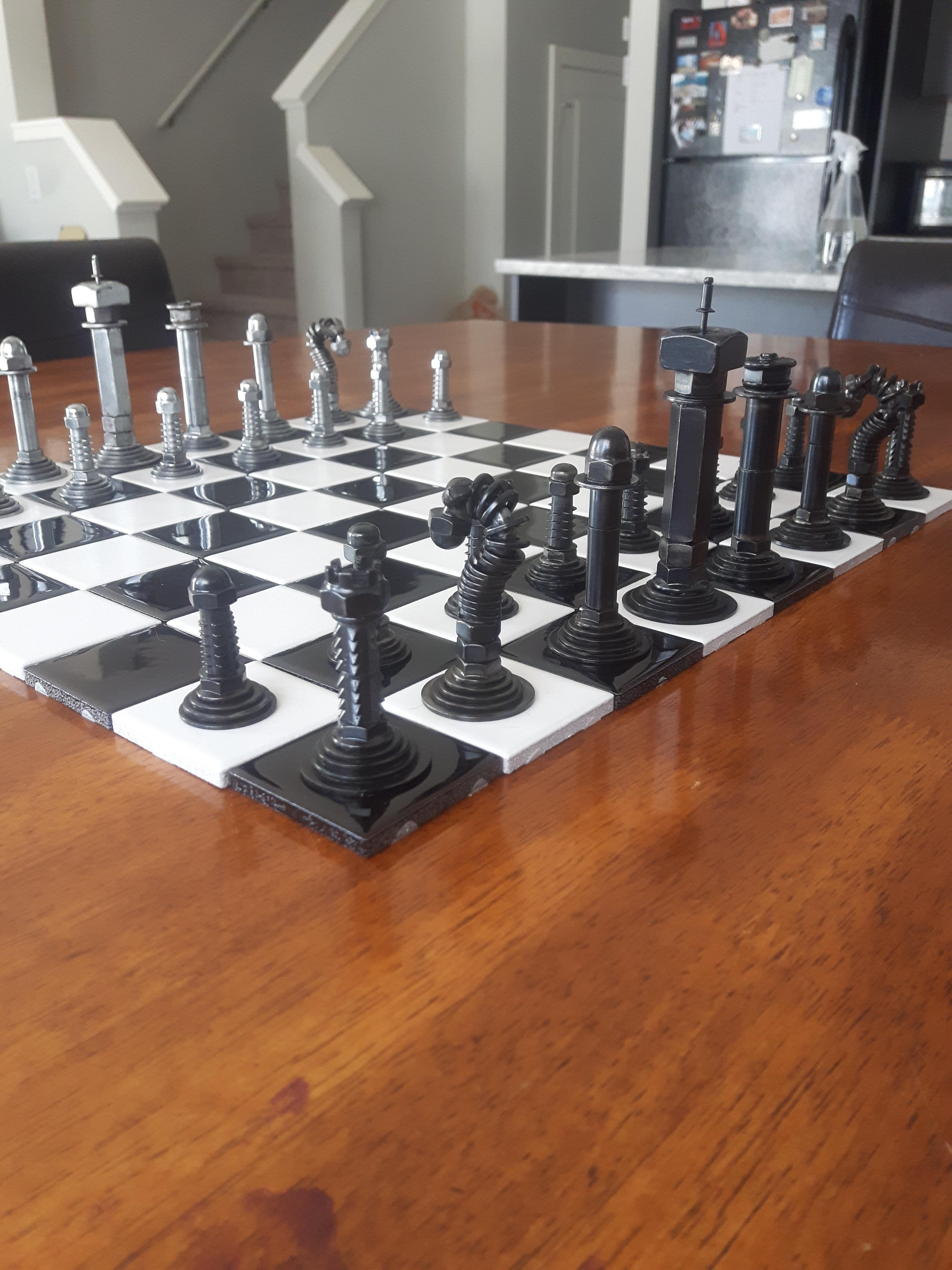


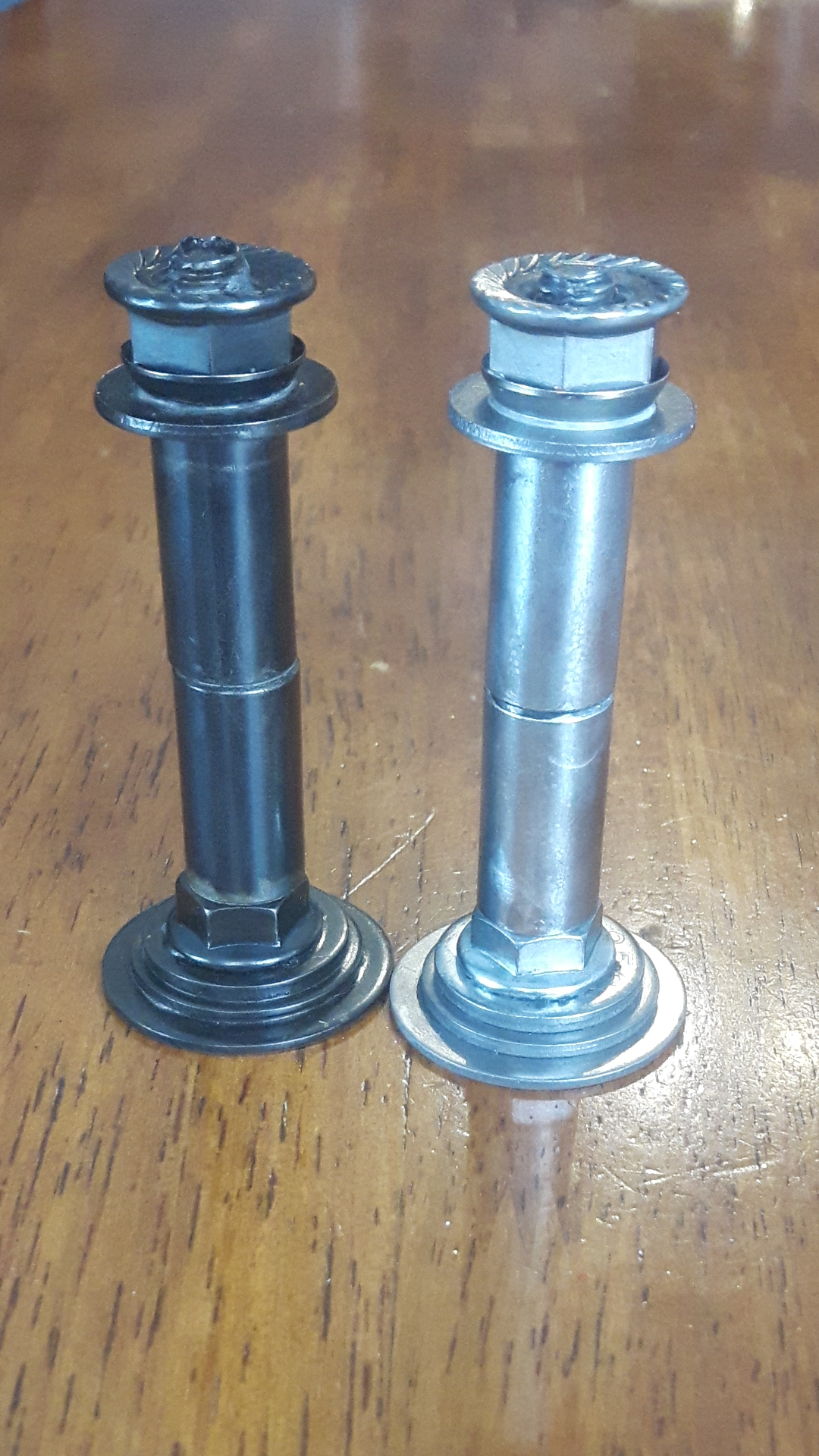




The first time I ever saw a hardware chess set was this instructable here and I knew I had to make one for myself. I loved the concept of using commonly available hardware to make chess pieces. With the large variety of hardware available I wanted to take the inspiration that instructable gave me and build my own unique set. Years have gone by since then, and I have had various ideas floating around in my head and now I finally got around to making it.
Materials and Tools
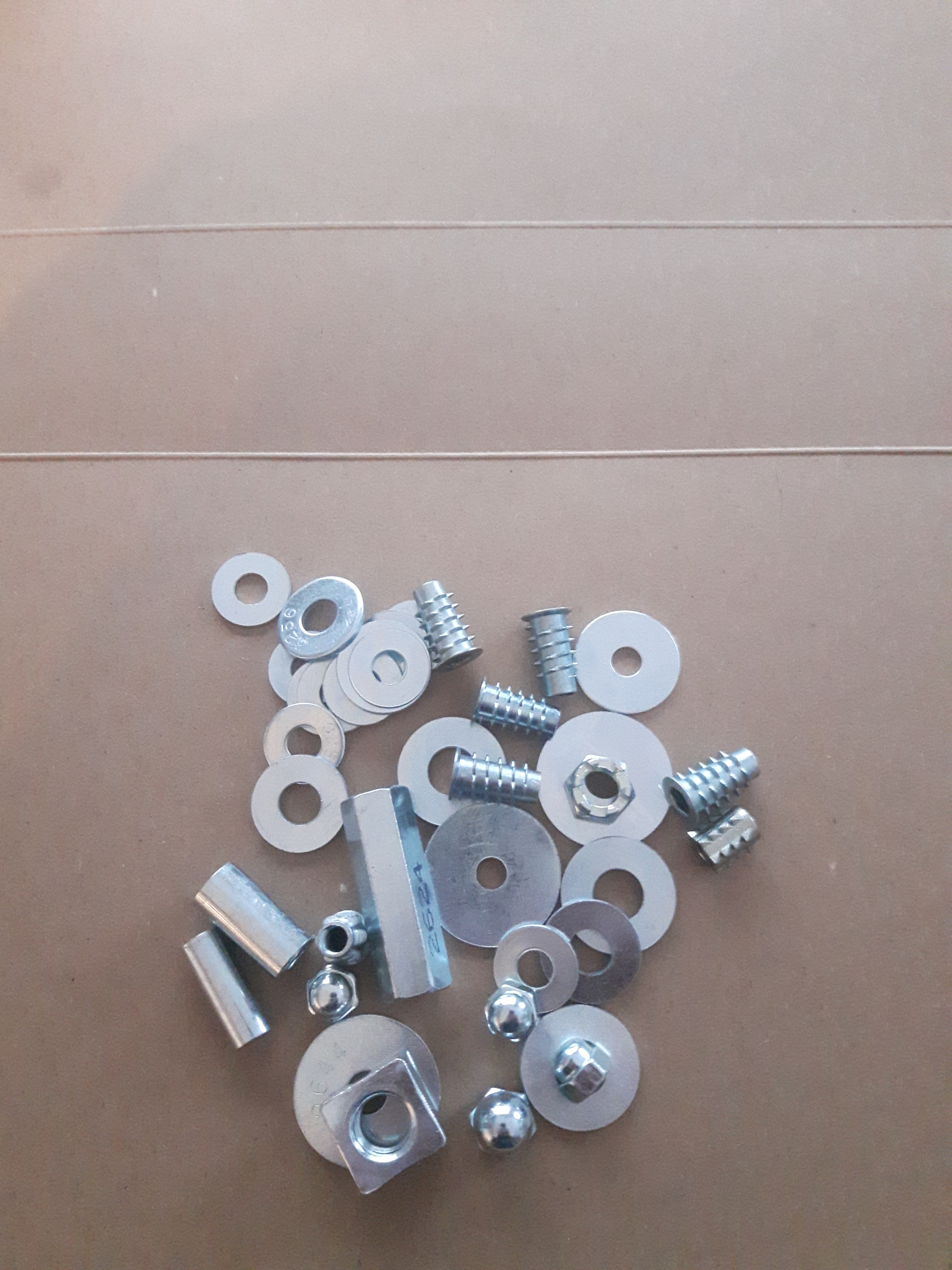





Materials:
A variety of hardware pieces (I will list the specific pieces in the description for each chess piece)
1/4", 5/16" and 3/8" treaded rod
Epoxy
Citric acid (the stuff I found was in the hardware store meant for etching concrete but it is also used in canning and for making bath bombs)
Gun blue
Clear coat
Tools:
Dremel rotary tool with cut off discs and a wire sanding wheel
Drill press
Pliers
A variety of hardware pieces (I will list the specific pieces in the description for each chess piece)
1/4", 5/16" and 3/8" treaded rod
Epoxy
Citric acid (the stuff I found was in the hardware store meant for etching concrete but it is also used in canning and for making bath bombs)
Gun blue
Clear coat
Tools:
Dremel rotary tool with cut off discs and a wire sanding wheel
Drill press
Pliers
Pawn
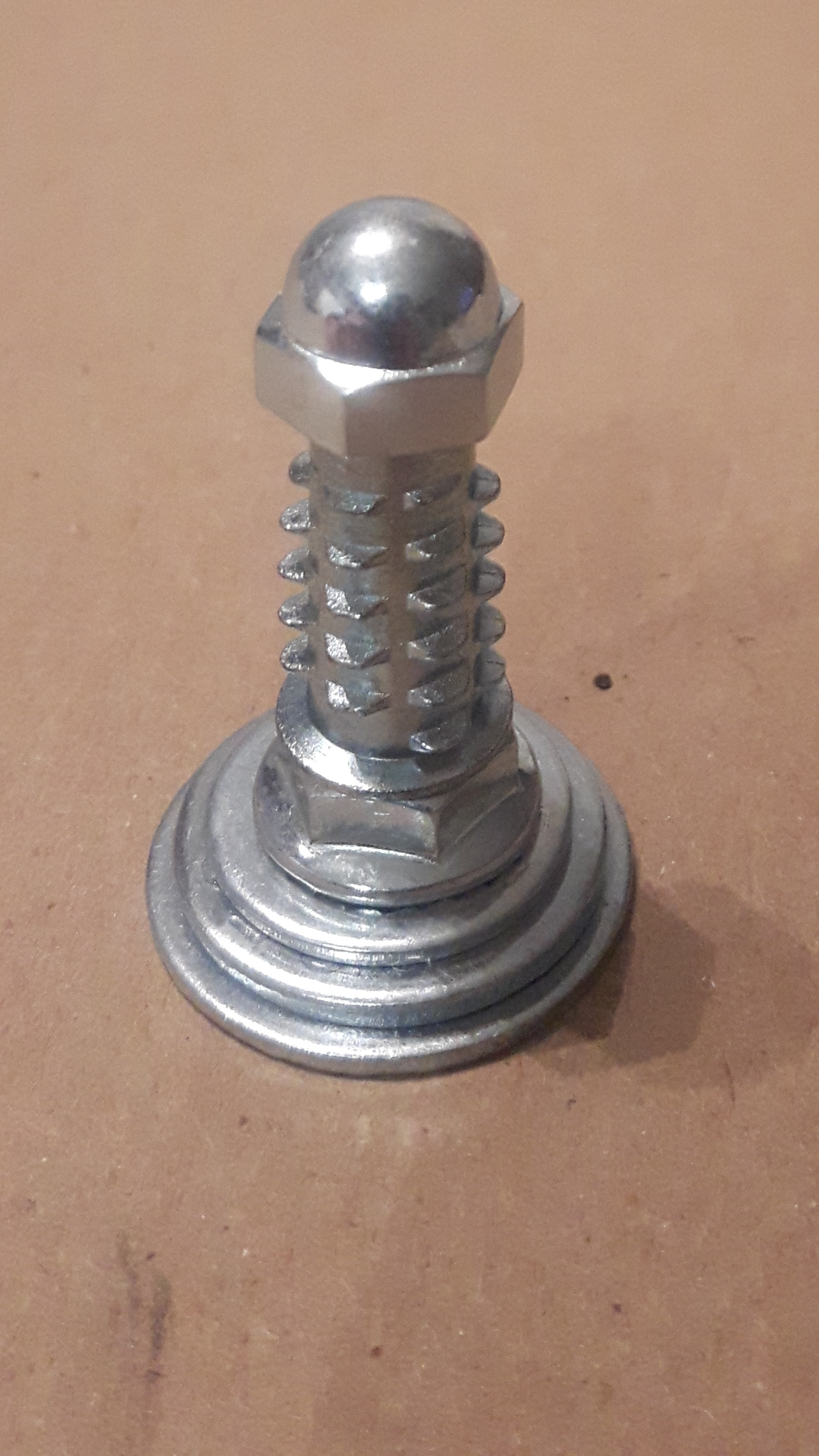

The pawn uses the following hardware:
1/4" × 1 1/2" threaded rod
1/4" × 1" fender washer
5/16" flat washer
1/4" flat washer
1/4" flanged nut
1/4" flanged insert nut
1/4" acorn nut
Use the dremel tool to cut a piece of 1/4" threaded rod to 1 1/2" long. Epoxy the washers together with the largest one on the bottom and the smallest on top. Make sure they are centered. Screw the flanged nut onto the threaded rod far enough that the rod will go through the washers but not stick out the other side at all. Put a little epoxy on the threads and screw the flanged insert nut onto the rod from the other end all the way down to the flanged nut. Put a little more epoxy on the threads and screw the acorn nut on top of that. Put some epoxy on the bottom of the flanged nut and center it on the stack of washers.
1/4" × 1 1/2" threaded rod
1/4" × 1" fender washer
5/16" flat washer
1/4" flat washer
1/4" flanged nut
1/4" flanged insert nut
1/4" acorn nut
Use the dremel tool to cut a piece of 1/4" threaded rod to 1 1/2" long. Epoxy the washers together with the largest one on the bottom and the smallest on top. Make sure they are centered. Screw the flanged nut onto the threaded rod far enough that the rod will go through the washers but not stick out the other side at all. Put a little epoxy on the threads and screw the flanged insert nut onto the rod from the other end all the way down to the flanged nut. Put a little more epoxy on the threads and screw the acorn nut on top of that. Put some epoxy on the bottom of the flanged nut and center it on the stack of washers.
Rook
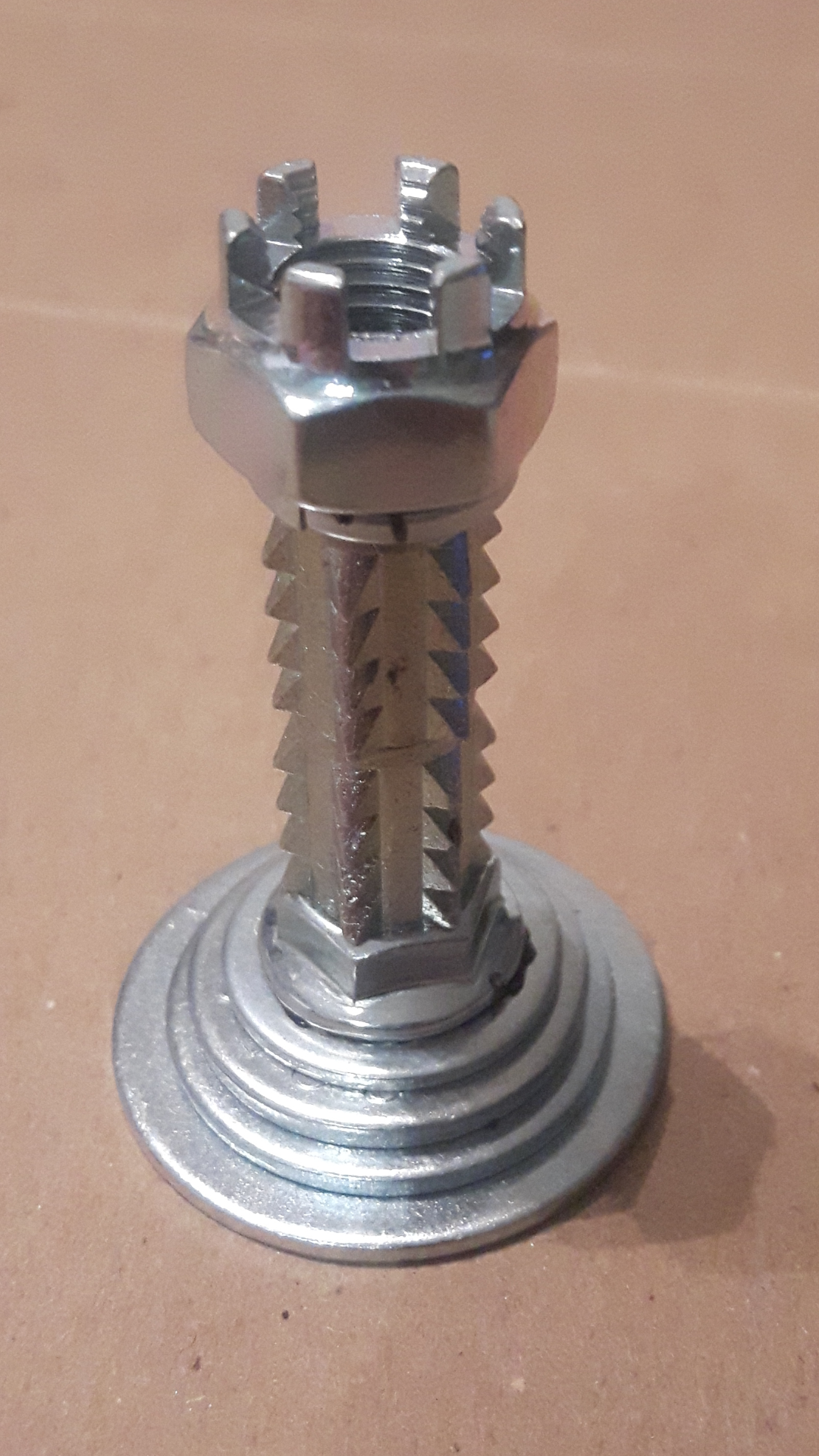

Hardware:
1/4" × 1 3/4" threaded rod
1/4" × 1 1/4" fender washer
3/8" flat washer
5/16" flat washer
1/4" flat washer
1/4" flanged nut
1/4" insert nut × 2 (non tapered)
1/4" split lock washer
5/16" castellated nut (castle nut)
As with the pawn, stack the washers from largest to smallest, put the flanged nut on the rod, and the insert nuts on top of that. Use pliers to flatten the split lock washer and epoxy it on top of the insert nuts and then epoxy the castellated nut on top of that. Put epoxy on the bottom of the flanged nut and attach to the stack of washers.
1/4" × 1 3/4" threaded rod
1/4" × 1 1/4" fender washer
3/8" flat washer
5/16" flat washer
1/4" flat washer
1/4" flanged nut
1/4" insert nut × 2 (non tapered)
1/4" split lock washer
5/16" castellated nut (castle nut)
As with the pawn, stack the washers from largest to smallest, put the flanged nut on the rod, and the insert nuts on top of that. Use pliers to flatten the split lock washer and epoxy it on top of the insert nuts and then epoxy the castellated nut on top of that. Put epoxy on the bottom of the flanged nut and attach to the stack of washers.
Knight


Materials:
1/4" × 2 1/2" eye bolt
1/4" × 1 1/4" fender washer
3/8" flat washer
5/16" flat washer
1/4" flat washer
1/4" flanged nut
1/4" nut × 2
1/4" split lock washer × 15
1/4" wing nut
1/4" acorn nut
Stack the washers as before. Cut the eye bolt down to 2 1/4" and cut the end off the eye to form a hook. Slide the wing nut over the end of the hook and the acorn nut onto the end. Epoxy both in place. Slide the split washers on from the other end and epoxy in place. You will likely have to do them one at a time at first to get them evenly spaced around the curve. Put the two nuts on next, followed by the flanged nut and then attach the whole thing to the washer stack.
1/4" × 2 1/2" eye bolt
1/4" × 1 1/4" fender washer
3/8" flat washer
5/16" flat washer
1/4" flat washer
1/4" flanged nut
1/4" nut × 2
1/4" split lock washer × 15
1/4" wing nut
1/4" acorn nut
Stack the washers as before. Cut the eye bolt down to 2 1/4" and cut the end off the eye to form a hook. Slide the wing nut over the end of the hook and the acorn nut onto the end. Epoxy both in place. Slide the split washers on from the other end and epoxy in place. You will likely have to do them one at a time at first to get them evenly spaced around the curve. Put the two nuts on next, followed by the flanged nut and then attach the whole thing to the washer stack.
Bishop

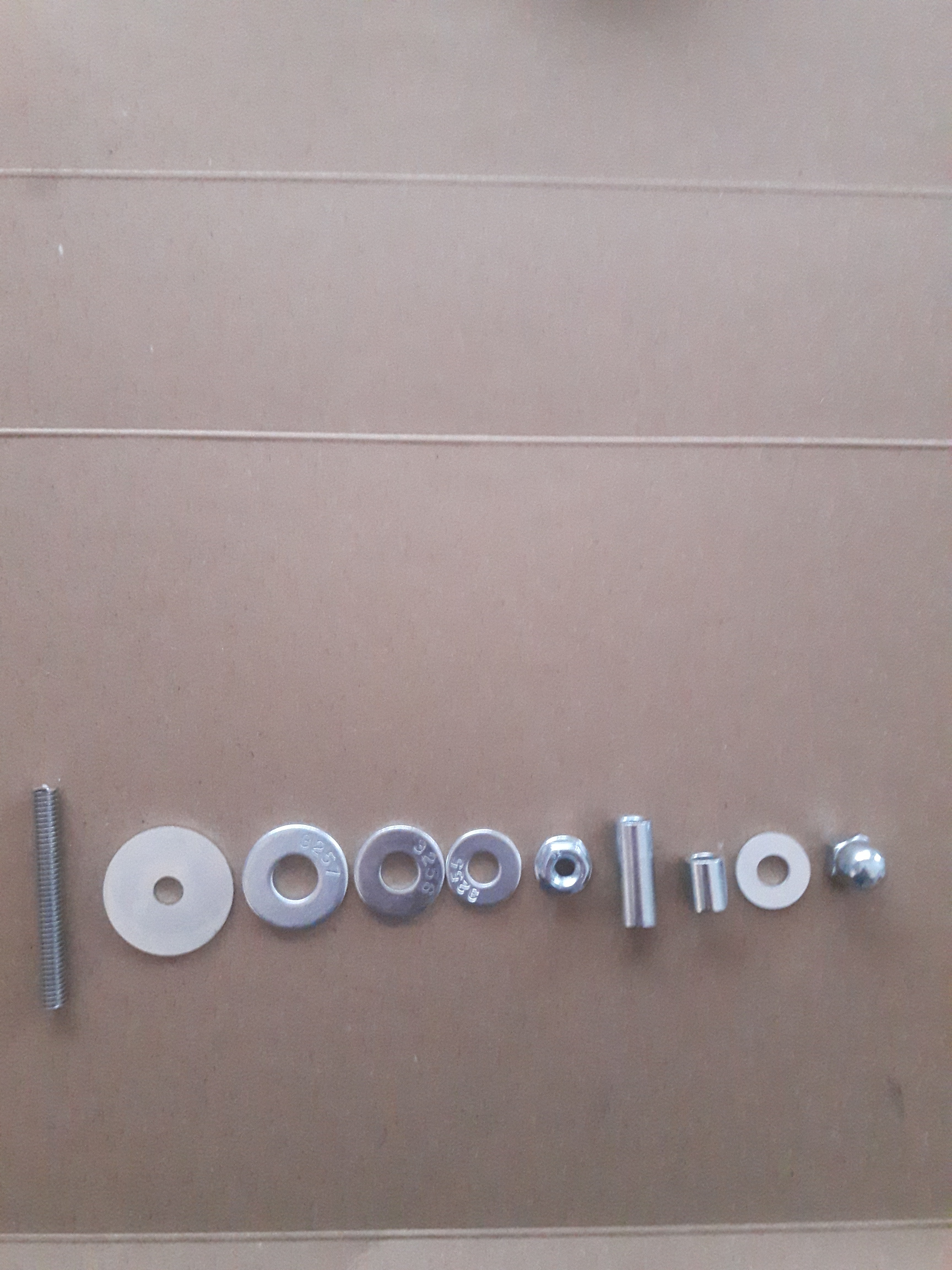
Materials:
1/4" × 2 3/8" threaded rod
1/4" × 1 1/4" fender washer
3/8" flat washer
5/16" flat washer
1/4" flat washer × 2
1/4" flanged nut
1/4" × 1" spacer
1/4" × 1/2" spacer
5/16" acorn nut
Stack the washers except the second 1/4" flat washer. Put the flanged nut on the rod and attach to the washer stack. Put the two spacers on top, followed by the second 1/4" flat washer and topped with the 5/16" acorn nut.
1/4" × 2 3/8" threaded rod
1/4" × 1 1/4" fender washer
3/8" flat washer
5/16" flat washer
1/4" flat washer × 2
1/4" flanged nut
1/4" × 1" spacer
1/4" × 1/2" spacer
5/16" acorn nut
Stack the washers except the second 1/4" flat washer. Put the flanged nut on the rod and attach to the washer stack. Put the two spacers on top, followed by the second 1/4" flat washer and topped with the 5/16" acorn nut.
Queen
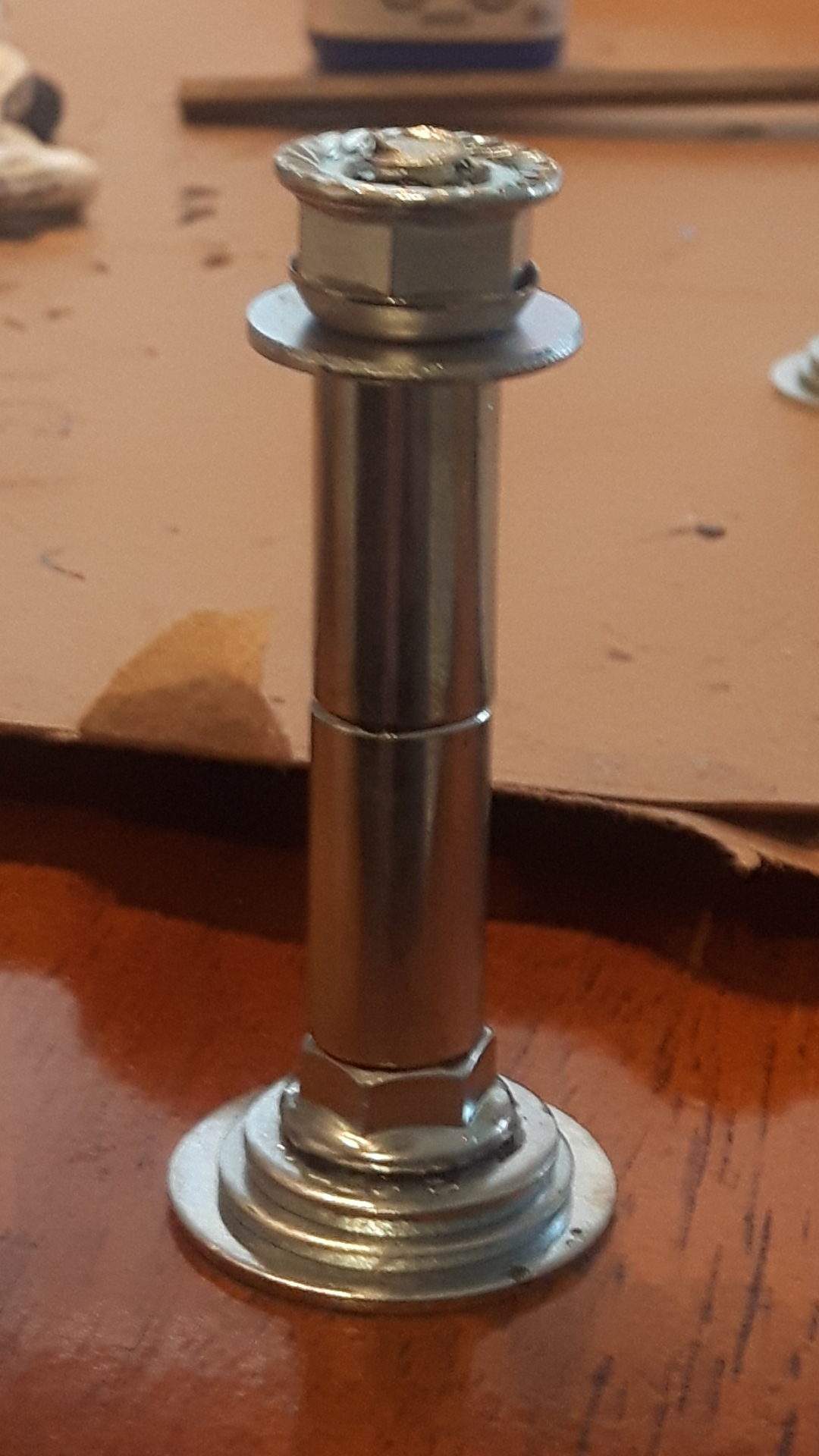

Materials:
5/16" × 3" threaded rod
5/16" × 1 1/4" fender washer
3/8" flat washer
5/16" flat washer × 2
5/16" flanged nut
5/16" × 1" spacer × 2
#12 finish washer
3/8" flanged nut
Stack the washers, except the second 5/16" flat washer and put the flanged nut on the rod. Attach the flanged nut/threaded rod assembly to the washer stack. Add the spacers, then the second 5/16" flat washer, the finish washer, curved upwards and finally top with the 3/8" flanged nut, upside down.
5/16" × 3" threaded rod
5/16" × 1 1/4" fender washer
3/8" flat washer
5/16" flat washer × 2
5/16" flanged nut
5/16" × 1" spacer × 2
#12 finish washer
3/8" flanged nut
Stack the washers, except the second 5/16" flat washer and put the flanged nut on the rod. Attach the flanged nut/threaded rod assembly to the washer stack. Add the spacers, then the second 5/16" flat washer, the finish washer, curved upwards and finally top with the 3/8" flanged nut, upside down.
King



Materials:
3/8" × 3 3/8" threaded rod
3/8" × 1 1/2" fender washer
5/16" × 1 1/4" fender washer
3/8" flat washer
5/16" flat washer × 2
3/8" flanged nut
3/8" nut × 2
3/8" coupling nut
1/2" square nut
1/8" steel rivet
Apparently, I forgot to take a picture of the materials before building the kings. I managed to scrounge up an example of everything except the coupling nut but it is plain to see in the finished product picture.
Drill a hole in one end of the threaded rod big enough for the shaft of the rivet to fit in. Cut the rivet shaft shorter so you don't have to drill as deep. Drill the center of the 5/16" fender washer bigger if it won't fit over the rod. Stack the washers, except the second 5/16" flat washer, and put the flanged nut on the end of the rod that does not have the hole. From the other end, add a 3/8" nut, then the coupling nut, 5/16" flat washer and the other nut. Top with the square nut and insert the rivet into the hole you drilled in the rod. Attach to the washer stack.
3/8" × 3 3/8" threaded rod
3/8" × 1 1/2" fender washer
5/16" × 1 1/4" fender washer
3/8" flat washer
5/16" flat washer × 2
3/8" flanged nut
3/8" nut × 2
3/8" coupling nut
1/2" square nut
1/8" steel rivet
Apparently, I forgot to take a picture of the materials before building the kings. I managed to scrounge up an example of everything except the coupling nut but it is plain to see in the finished product picture.
Drill a hole in one end of the threaded rod big enough for the shaft of the rivet to fit in. Cut the rivet shaft shorter so you don't have to drill as deep. Drill the center of the 5/16" fender washer bigger if it won't fit over the rod. Stack the washers, except the second 5/16" flat washer, and put the flanged nut on the end of the rod that does not have the hole. From the other end, add a 3/8" nut, then the coupling nut, 5/16" flat washer and the other nut. Top with the square nut and insert the rivet into the hole you drilled in the rod. Attach to the washer stack.
Finishing


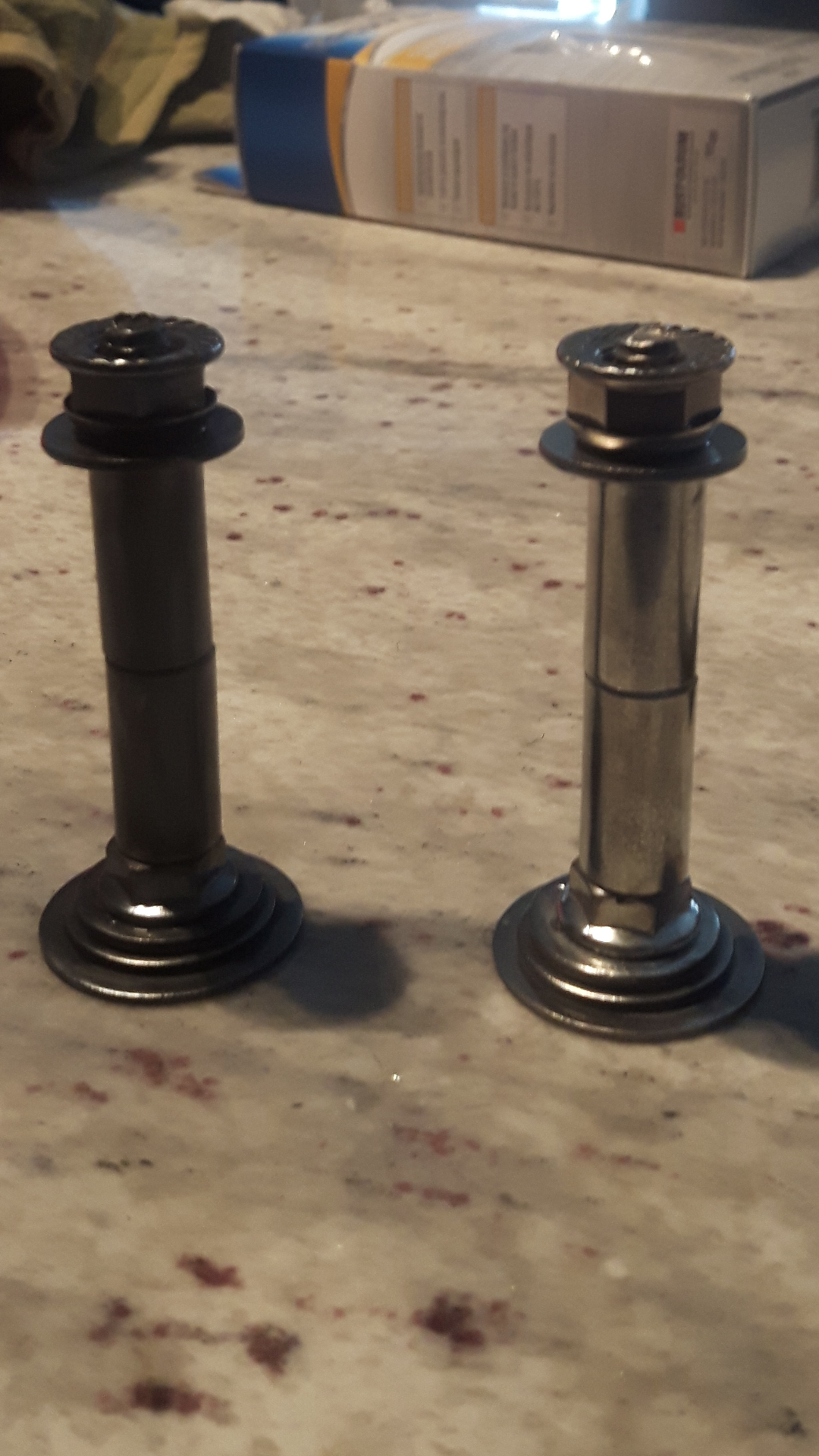
Mix up the citric acid in a plastic container and put the chess pieces in. Let soak for about 1 1/2 hours to dissolve the zinc coating. It doesn't seem to give off any fumes doing this but I would put it in a well ventilated area just to be safe. Once the zinc has dissolved, rinse the pieces with water and dry them off. Then polish them up with the wire wheel in your dremel. Give half of the pieces two coats of gun blue, rinsing with water, drying and polishing after each coat. Finally, give them all a couple light coats of protective clear coating.